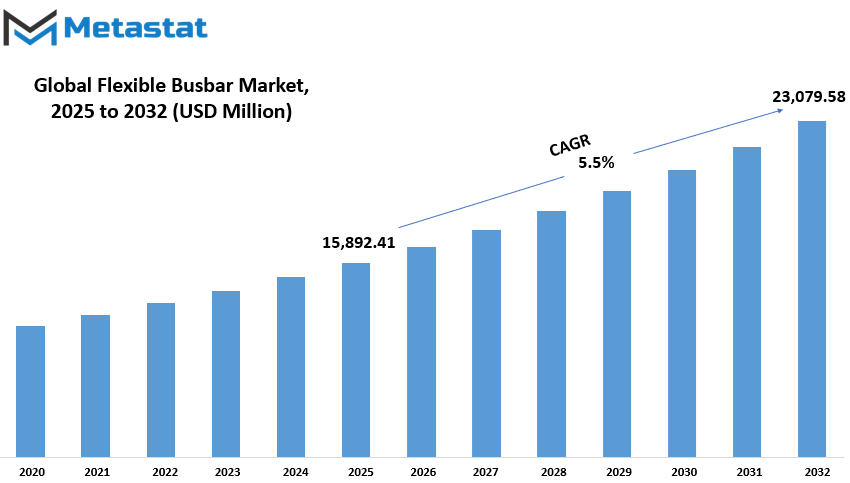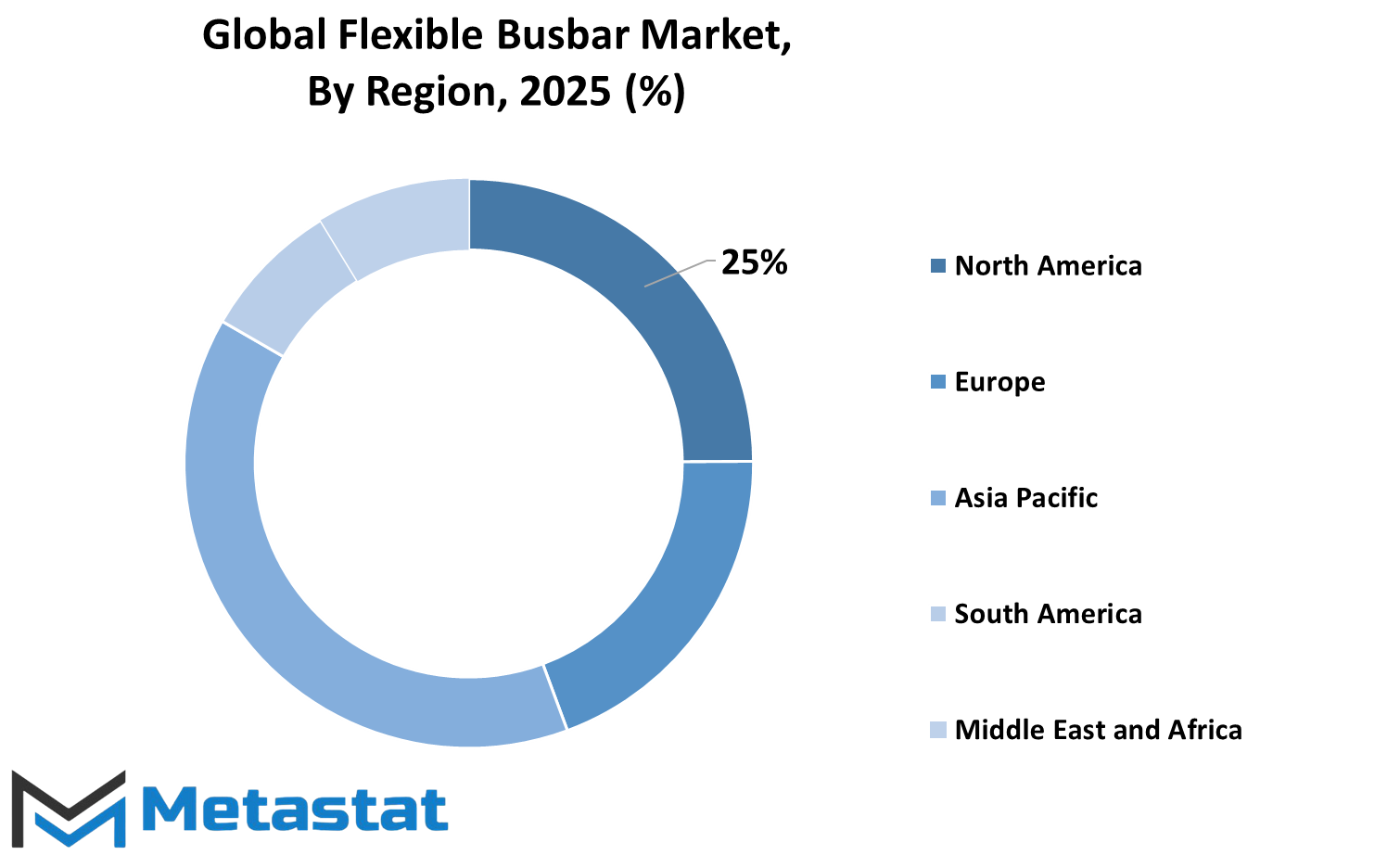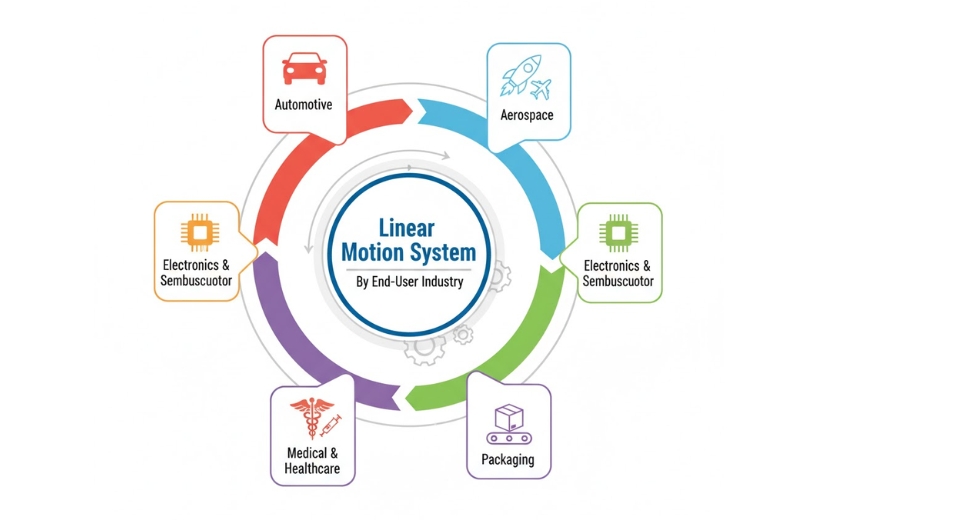MARKET OVERVIEW
The Global Flexible Busbar market will be the future backbone of the electrical and electronics industry. It is set to continue innovating the solutions for power distribution systems across industries. It is going to be more vital in the market because the demand for compact and efficient power systems increases. Flexible busbars are a means to make power distribution simpler in complicated electrical setups. Industries will revolutionize the management of electrical currents in the near future. These systems will be of prime importance in applications like telecommunications, industrial automation, and renewable energy, where flexibility and space-saving features are vital.
In the near future, the market will see an increased adoption rate as flexible busbars can connect electrical components efficiently in a variety of applications. These systems are designed to ensure the safe and reliable transmission of electrical energy while offering a degree of flexibility that traditional copper or aluminum busbars cannot match. The Global Flexible Busbar market will evolve with these technological advancements, pushing for lighter, more efficient designs that meet the growing demands of modern electrical systems. These systems will provide easier and more flexible installations, minimizing the complexity of interconnecting multiple devices.
The tendency towards miniaturization in electronic devices will continue to drive development in the market. As the size of electrical components continues to shrink, manufacturers will seek solutions that maintain high performance while minimizing the footprint of power distribution units. The Global Flexible Busbar market would cater to all these needs through compact, but highly effective electrical transmission solutions with no compromise in performance. Its increased usage is also closely interlinked with that of electric vehicles and renewable energy systems, for which space-saving and adaptable electrical systems will soon become a need.
The increasing infrastructures of renewable energy, especially the solar and wind power systems, will have applications in the flexible busbars connecting solar panels to the grid and integrating energy storage solutions. Since these systems are lightweight and adaptable, they offer a higher degree of efficiency in energy transfer and will be ineluctable for the future of renewable energy. During that period, improved development of the global flexible busbar market regarding its new material will be more sophisticated in conductiveness and better quality in order to improve strength at high demanding application.
The use of flexible busbars in industrial automation will also continue to grow as automation systems require more compact and flexible electrical layouts. Manufacturers will demand solutions that allow for easy adjustments in their production lines and assembly processes, which flexible busbars will be able to provide. These systems will allow for quicker, safer, and more cost-effective installations in automated environments, where precision and flexibility are essential. With increased demand for high-performance, energy-efficient systems globally, the flexible busbar market will continue to experience interest.
The Global Flexible Busbar market will face new challenges and regulatory standards due to the evolution of electrical and electronic systems. It will ensure that future applications are safe, reliable, and efficient. Continued focus on energy consumption reduction and improvement in system efficiencies will drive further innovations in even more flexible busbar solutions, solidifying their role as a fundamental component in modern power distribution systems.
Global Flexible Busbar market is estimated to reach $23,079.58 Million by 2032; growing at a CAGR of 5.5% from 2025 to 2032.

GROWTH FACTORS
The global flexible busbar market is expanding mainly because of several drivers for the demand in this market. It finds major applications in data centers, electric vehicles, and renewable energy. In such various industries and businesses using power distribution systems, compact and efficient solutions continue to be on the rise for advanced technologies. Flexible busbars are well-suited because they are used in the transmission of electrical power. In applications, such as data centers and electric vehicles, critical are space and efficiency. The trend is also ongoing about the widespread adoption of renewable energy sources, where reliability power connections in the installations guarantee smooth energy distribution.
However, the promising growth in flexible busbar markets comes with a few challenges. The primary concern is the high production cost that accompanies the manufacture of flexible busbars. This tends to be more expensive than the traditional rigid busbar. Such cost factors might limit their adoption in regions or industries with budget constraints. In addition, flexible busbars have limited current-carrying capacity, which makes them less suitable for heavy-duty industrial applications that require robust power transfer.
Despite these challenges, there are still immense opportunities on the horizon for the flexible busbar market. The most typical opportunity is seen in the growing adoption of flexible busbars in electric vehicles and battery energy storage systems. With increasing demand in electric vehicles, the need for more efficient power transfer has set manufacturers to look for an ideal solution in flexible busbars. These busbars enhance the efficiency of power transfer between various components in an electric vehicle and are therefore essential for optimal performance. Similarly, flexible busbars used in battery energy storage systems help in the efficient management of power flow and make them a great choice for energy storage applications.
Demand for flexible busbars will increase in the coming years because of growing demand for electric vehicles, renewable energy installations, and battery storage systems. The higher efficiency and cost-effectiveness that can be achieved by flexible busbars with continued improvements in technology are expected to boost market potential. This would offer opportunities to both manufacturers and investors. With a focus on innovation and meeting the evolving needs of modern power distribution systems, the flexible busbar market is poised for continued growth.
MARKET SEGMENTATION
By Type
The global flexible busbar market is experiencing high growth as industries continue to look for efficient and reliable solutions for electrical distribution. This market is segmented by power types, catering to different power requirements in various applications. Low power, medium power, and high power categories make up the segmentation, each catering to different needs and industries.
Low power covers systems with less than 125 A, with a value of around $5,049.46 million. This segment focuses on smaller electrical systems that are compact, efficient, and easy to install. Low power flexible busbars are utilized in applications that do not necessarily require high power but still require reliability and easy installation. Demand in this segment is seen in consumer electronics, telecommunication, and residential applications where space constraints and the need for flexible connections are the main issues.
The medium power segment deals with systems between 125 A and 800 A. The medium power flexible busbars find application in almost all industries that are into manufacturing, automation, and building infrastructure. These systems demand efficiency, size, and cost-effectiveness; thus the medium power busbar shall act as an essential part in larger electrical distribution systems. Medium power busbars, therefore, remain the cornerstone for delivering complexity yet not compromising on reliability in the power delivery of industrially expanding and even more complicated electrical networks.
The high power segment, which includes systems above 800 A, accounts for the largest share of the market. High-demand environments include data centers, industrial plants, and large-scale electrical installations. The high power flexible busbars are designed to carry heavy electrical loads while maintaining safe, stable, and efficient power distribution. There is an increased demand for energy-efficient solutions in large industrial and commercial settings that necessitates the use of high-power systems because they are a reliable solution for complex electrical needs.
The global flexible busbar market is therefore growing as more industries rely on adaptable and reliable power distribution systems. With segments specifically designed to meet different power needs, the market is perfectly positioned to accommodate a wide range of applications, thus ensuring that electrical systems remain efficient, flexible, and capable of handling the increasing demands of modern infrastructure.
By Material
The Global Flexible Busbar is an important and integral part in the electrical line of business to connect and spread power across diversified systems with least loss. For the most part, the business is segmented based on two essential materials: Copper and Aluminum each with their varied advantages in view of application areas.
Copper is one among the most frequent materials used due to excellent current-carrying capacity. It ensures smooth and minimal loss flow of electrical energy, which is ideal for high-performance applications like power distribution in data centers, industrial setups, and electrical grids. The durability of copper also makes a big contribution to the length of life for the busbars, thus ensuring that projects which require long-term performance will benefit from these. However, the cost of copper is a significant factor for companies in making decisions on material choices for flexible busbars. Though it is expensive, its conductivity and strength are better than those of other materials, and thus it is used in critical systems where efficiency is paramount.
Aluminum, on the other hand, is more cost-effective and thus a popular alternative to copper in many applications. Though less conductive than copper, aluminum works well in most applications, and the reduced size of the busbar often adequately compensates for the reduced conductivity. Aluminum is also less heavy than copper, which is why it is suitable for applications in which weight needs to be saved. This therefore makes it very appealing to industries such as transportation, construction, and renewable energy where cost efficiency and weight play a great role.
Both materials—copper and aluminum—are selected with specific requirements and constraints, including cost, performance, and application needs. For example, for high-power capacity and efficiency, industries would select copper. Aluminum is suitable when the need is for a lighter, less expensive solution. The capabilities of both copper and aluminum busbars continue to advance due to developments in material science, making them useful in many applications.
The Global Flexible Busbar market continues to grow with an increasing demand for efficient power distribution solutions across various industries. Between copper and aluminum, the material of choice will depend on trade-offs between cost, conductivity, and application requirements. Both have their places in the market, and the choices made between them will evolve over time as technology improves and sectors change their requirements.
By Application
The Global Flexible Busbar market is expanding with more efficient electrical systems. It's influenced by multiple factors, the most significant ones being the evolution of technology and the need for flexible and efficient power distribution across various sectors. A flexible busbar, which is a conductor used to transmit electricity, is becoming a preferred solution due to its adaptability, ease of installation, and ability to carry large amounts of power in tight spaces. This market can be categorized based on the applications in which these busbars are used, namely residential, commercial, and industrial sectors.
The demand for flexible busbars in the residential sector is increasing because smart technology and renewable energy systems like solar panels are being adopted in most homes. These busbars are flexible and easily integrated into already existing electrical systems, making it possible to adapt them according to the needs of modern homes. This increased reliance on electricity for daily operations and the increased availability of energy-efficient products is thereby increasing the demand for safe, reliable, and space-efficient power distribution solutions.
The commercial sector is also gaining a lot of momentum in this regard. As businesses are becoming more conscious of energy usage and invest in large electrical systems, there is a strong need for flexible and compact power distribution systems. Flexible busbars are perfect for commercial use because they are applied in many areas, such as lighting, HVAC systems, and complex electrical grids. Their capacity to handle heavy loads and flexibility in accommodating the physical structure of buildings make them a critical part of powering commercial establishments efficiently.
The primary driver of the demand for flexible busbars in the industrial sector is the growing need for a reliable power distribution system in factories, plants, and large-scale operations. Flexibility in heavy industries is crucial as the power systems must be robust, safe, and flexible enough to meet increasingly dynamic operational conditions. Their use in industrial applications helps prevent power loss, reduce maintenance costs, and streamline the installation process, making them an attractive choice for industries looking to improve their electrical infrastructure.
To put it in simpler words, the Global Flexible Busbar market will surge because of its usage in any electrical setup across the globe: from residential buildings to commercial, as well as industries. Being very flexible and energy-efficient while accommodating specific sector requirements is adding them as one of the hot products in use and is sure to increase the same as there would be more requirements for effective energy solutions on this planet earth.
|
Forecast Period |
2025-2032 |
|
Market Size in 2025 |
$15,892.41 million |
|
Market Size by 2032 |
$23,079.58 Million |
|
Growth Rate from 2024 to 2031 |
5.5% |
|
Base Year |
2024 |
|
Regions Covered |
North America, Europe, Asia-Pacific, South America, Middle East & Africa |
REGIONAL ANALYSIS
The Flexible Busbar market is categorized based on geography into regions, including North America, Europe, Asia-Pacific, South America, and the Middle East & Africa. North America has further segmented the market into the U.S., Canada, and Mexico. Europe includes key countries such as the UK, Germany, France, Italy, and other nations grouped under the Rest of Europe. Asia-Pacific would be further broken down into the following countries, namely India, China, Japan, South Korea, and the Rest of Asia-Pacific. South America would comprise countries such as Brazil, Argentina, and the Rest of South America. Finally, Middle East & Africa would be split up into the countries of GCC, Egypt, South Africa, and the Rest of Middle East & Africa.
This classification provides a clearer view of how the market is spread across various parts of the world, and each region has its own characteristics that influence the growth and development of the market. Segmentation helps in analyzing demand and supply trends, identifying growth opportunities, and understanding regional challenges that might affect the market. For example, North America is likely to take a lead in market adoption with developed infrastructure and highly developed technologies; similarly, the Asia-Pacific region will rapidly grow based on increased industrial sectors and heavy urbanization within the respective regions.
The energy and manufacturing sectors within South America and the Middle East & Africa will equally gain momentum. Categorizing the market this way enables firms to tailor strategies aimed at the particular demands and trends prevailing in each region. For any investor targeting or expanding into the Flexible Busbar market, these geographical dynamics are key to explore.

COMPETITIVE PLAYERS
The global Flexible Busbar market is growing rapidly because of the necessity of efficient power distribution systems from various industries. These systems play a vital role in managing the electrical connections of industrial and commercial buildings. The applications of flexible busbars range from power generation, renewable energy, automotive, telecommunication, to data centers. This versatility has made flexible busbars an attractive solution for modern infrastructure. Further expansion is possible with technological development, providing higher efficiency and flexibility in electrical designs.
Key players in the Flexible Busbar industry include several major global companies that have established themselves as leaders in the field. Among them are ABB Ltd., Siemens AG, Schneider Electric, Eaton Corporation, Salzer Electronics Limited, and Zhejiang RHI Electric Co., Ltd. These companies are known for their innovative approaches and commitment to developing high-quality products that meet the growing demand for reliable power systems.
Apart from these global players, there are other companies like Phynyx Industrial Products Pvt. Ltd, Galco Industrial Electronics, and Anord Mardix that significantly contribute to the industry. These companies focus on offering a wide range of busbar solutions tailored to different sectors, ensuring that businesses and industrial clients can find the right fit for their needs. Other important names in the market include Mersen, Legrand, nVent, ENNOVI, and Schrack Technik Group, who continuously innovate and ensure their products are at the forefront of electrical distribution technology.
Other notable players in the market include SVM, Mouser Electronics, Inc., Rittal, and TORSION INDUSTRIES. These companies are smaller but have a significant presence in the market. They are crucial for the growth of the Flexible Busbar market, offering different options for customization and enhancing the overall flexibility of electrical systems in various industries. These companies are focusing on expanding their reach and increasing their production capacity to meet the growing demand for energy-efficient and space-saving solutions.
The Flexible Busbar market is poised to take a significant share in the world's energy-efficient power solutions demand. The stiff competition among the key players guarantees that innovative products and solutions are steadily available to fulfill the varied demands of different industries. This competition propels new technologies and solutions that will be used in the Flexible Busbar market.
Flexible Busbar Market Key Segments:
By Type
- Low Power (Below 125 A)
- Medium Power (125 A–800 A)
- High Power (Above 800 A)
By Material
- Copper
- Aluminum
By Application
- Residential
- Commercial
- Industrial
Key Global Flexible Busbar Industry Players
- ABB Ltd.
- Siemens AG
- Schneider Electric
- Eaton Corporation
- Salzer Electronics Limited
- Zhejiang RHI Electric Co.,Ltd
- Phynyx Industrial Products Pvt. Ltd
- Galco Industrial Electronics
- Anord Mardix
- Mersen
- Legrand
- nVent
- ENNOVI
- Schrack Technik Group
- SVM
- Mouser Electronics, Inc.
- Rittal
- TORSION INDUSTRIES
WHAT REPORT PROVIDES
- Full in-depth analysis of the parent Industry
- Important changes in market and its dynamics
- Segmentation details of the market
- Former, on-going, and projected market analysis in terms of volume and value
- Assessment of niche industry developments
- Market share analysis
- Key strategies of major players
- Emerging segments and regional growth potential







 US: +1 3023308252
US: +1 3023308252






